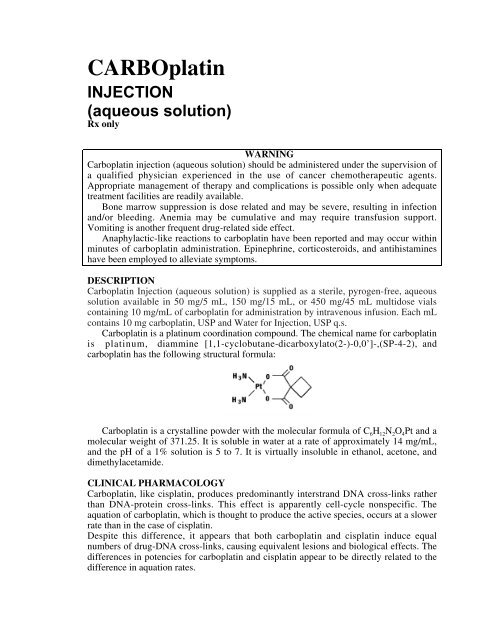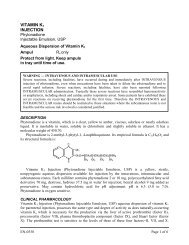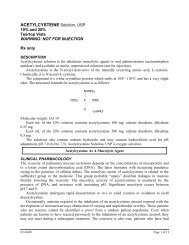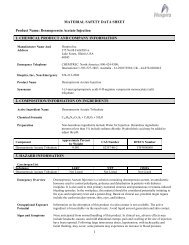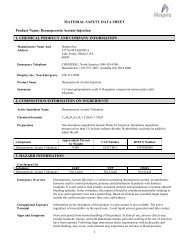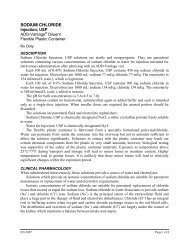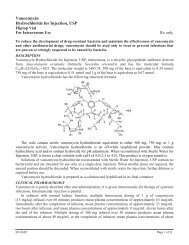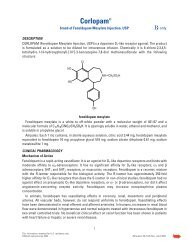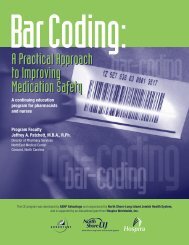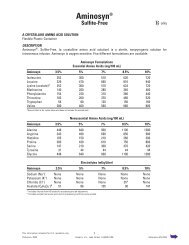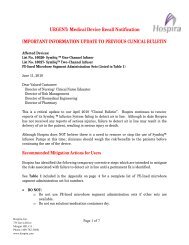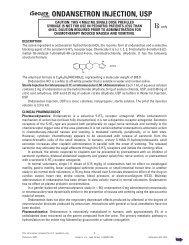CARBOplatin INJECTION (aqueous solution) - Hospira
CARBOplatin INJECTION (aqueous solution) - Hospira
CARBOplatin INJECTION (aqueous solution) - Hospira
You also want an ePaper? Increase the reach of your titles
YUMPU automatically turns print PDFs into web optimized ePapers that Google loves.
<strong>CARBOplatin</strong><br />
<strong>INJECTION</strong><br />
(<strong>aqueous</strong> <strong>solution</strong>)<br />
Rx only<br />
WARNING<br />
Carboplatin injection (<strong>aqueous</strong> <strong>solution</strong>) should be administered under the supervision of<br />
a qualified physician experienced in the use of cancer chemotherapeutic agents.<br />
Appropriate management of therapy and complications is possible only when adequate<br />
treatment facilities are readily available.<br />
Bone marrow suppression is dose related and may be severe, resulting in infection<br />
and/or bleeding. Anemia may be cumulative and may require transfusion support.<br />
Vomiting is another frequent drug-related side effect.<br />
Anaphylactic-like reactions to carboplatin have been reported and may occur within<br />
minutes of carboplatin administration. Epinephrine, corticosteroids, and antihistamines<br />
have been employed to alleviate symptoms.<br />
DESCRIPTION<br />
Carboplatin Injection (<strong>aqueous</strong> <strong>solution</strong>) is supplied as a sterile, pyrogen-free, <strong>aqueous</strong><br />
<strong>solution</strong> available in 50 mg/5 mL, 150 mg/15 mL, or 450 mg/45 mL multidose vials<br />
containing 10 mg/mL of carboplatin for administration by intravenous infusion. Each mL<br />
contains 10 mg carboplatin, USP and Water for Injection, USP q.s.<br />
Carboplatin is a platinum coordination compound. The chemical name for carboplatin<br />
is platinum, diammine [1,1-cyclobutane-dicarboxylato(2-)-0,0’]-,(SP-4-2), and<br />
carboplatin has the following structural formula:<br />
Carboplatin is a crystalline powder with the molecular formula of C 6H 12N 2O 4Pt and a<br />
molecular weight of 371.25. It is soluble in water at a rate of approximately 14 mg/mL,<br />
and the pH of a 1% <strong>solution</strong> is 5 to 7. It is virtually insoluble in ethanol, acetone, and<br />
dimethylacetamide.<br />
CLINICAL PHARMACOLOGY<br />
Carboplatin, like cisplatin, produces predominantly interstrand DNA cross-links rather<br />
than DNA-protein cross-links. This effect is apparently cell-cycle nonspecific. The<br />
aquation of carboplatin, which is thought to produce the active species, occurs at a slower<br />
rate than in the case of cisplatin.<br />
Despite this difference, it appears that both carboplatin and cisplatin induce equal<br />
numbers of drug-DNA cross-links, causing equivalent lesions and biological effects. The<br />
differences in potencies for carboplatin and cisplatin appear to be directly related to the<br />
difference in aquation rates.
In patients with creatinine clearances of about 60 mL/min or greater, plasma levels of<br />
intact carboplatin decay in a biphasic manner after a 30 minute intravenous infusion of<br />
300 to 500 mg/m 2 of carboplatin. The initial plasma half-life (alpha) was found to be 1.1<br />
to 2 hours (n = 6), and the post-distribution plasma half-life (beta) was found to be 2.6 to<br />
5.9 hours (n = 6). The total body clearance, apparent volume of distribution and mean<br />
residence time for carboplatin are 4.4 L/hour, 16 L and 3.5 hours, respectively. The C max<br />
values and areas under the plasma concentration vs time curves from 0 to infinity (AUC<br />
inf) increase linearly with dose, although the increase was slightly more than dose<br />
proportional. Carboplatin, therefore, exhibits linear pharmacokinetics over the dosing<br />
range studied (300 to 500 mg/m 2 ).<br />
Carboplatin is not bound to plasma proteins. No significant quantities of proteinfree,<br />
ultrafilterable platinum-containing species other than carboplatin are present in plasma.<br />
However, platinum from carboplatin becomes irreversibly bound to plasma proteins and<br />
is slowly eliminated with a minimum half-life of 5 days.<br />
The major route of elimination of carboplatin is renal excretion. Patients with<br />
creatinine clearances of approximately 60 mL/min or greater excrete 65% of the dose in<br />
the urine within 12 hours and 71% of the dose within 24 hours. All of the platinum in the<br />
24 hour urine is present as carboplatin. Only 3% to 5% of the administered platinum is<br />
excreted in the urine between 24 and 96 hours. There are insufficient data to determine<br />
whether biliary excretion occurs.<br />
In patients with creatinine clearances below 60 mL/min the total body and renal<br />
clearances of carboplatin decrease as the creatinine clearance decreases. Carboplatin<br />
dosages should therefore be reduced in these patients (see DOSAGE AND<br />
ADMINISTRATION section).<br />
The primary determinant of carboplatin clearance is glomerular filtration rate (GFR)<br />
and this parameter of renal function is often decreased in elderly patients. Dosing<br />
formulas incorporating estimates of GFR (see DOSAGE AND ADMINISTRATION<br />
section) to provide predictable carboplatin plasma AUCs should be used in elderly<br />
patients to minimize the risk of toxicity.<br />
CLINICAL STUDIES<br />
Use with Cyclophosphamide for Initial Treatment of Ovarian Cancer: In two<br />
prospectively randomized, controlled studies conducted by the National Cancer Institute<br />
of Canada, Clinical Trials Group (NCIC) and the Southwest Oncology Group (SWOG),<br />
789 chemotherapy naive patients with advanced ovarian cancer were treated with<br />
carboplatin or cisplatin, both in combination with cyclophosphamide every 28 days for<br />
six courses before surgical reevaluation. The following results were obtained from both<br />
studies:<br />
Comparative Efficacy:<br />
Overview of Pivotal Trials<br />
NCIC SWOG<br />
Number of patients randomized 447 342<br />
Median age (years) 60 62<br />
Dose of cisplatin 75 mg/m 2<br />
100 mg/m 2<br />
Dose of carboplatin 300 mg/m 2 300 mg/m 2<br />
Dose of cyclophosphamide 600 mg/m 2<br />
600 mg/m 2<br />
Residual tumor < 2 cm<br />
(number of patients)<br />
39% (174/447) 14% (49/342)
Clinical Response in Measurable Disease Patients<br />
NCIC SWOG<br />
Carboplatin (number of patients) 60% (48/80) 58% (48/83)<br />
Cisplatin (number of patients) 58% (49/85) 43% (33/76)<br />
95% C.I. of difference<br />
(Carboplatin – Cisplatin)<br />
(-13.9%, 18.6%) (-2.3%, 31.1%)<br />
Pathologic Complete Response*<br />
NCIC SWOG<br />
Carboplatin (number of patients) 11% (24/224) 10% (17/171)<br />
Cisplatin (number of patients) 15% (33/223) 10% (17/171)<br />
95% C.I. of difference<br />
(-10.7%, 2.5%) (-6.9%, 6.9%)<br />
(Carboplatin – Cisplatin)<br />
* 114 Carboplatin and 109 Cisplatin patients did not undergo second look surgery in NCIC study.<br />
90 Carboplatin and 106 Cisplatin patients did not undergo second look surgery in SWOG study.<br />
Progression-Free Survival (PFS)<br />
NCIC SWOG<br />
Median<br />
Carboplatin 59 weeks 49 weeks<br />
Cisplatin<br />
2 year PFS*<br />
61 weeks 47 weeks<br />
Carboplatin 31% 21%<br />
Cisplatin 31% 21%<br />
95% C.I. of difference<br />
(Carboplatin – Cisplatin)<br />
3 year PFS*<br />
(-9.3, 8.7) (-9.0, 9.4)<br />
Carboplatin 19% 8%<br />
Cisplatin 23% 14%<br />
95% C.I. of difference<br />
(Carboplatin – Cisplatin)<br />
(-11.5, 4.5) (-14.1, 0.3)<br />
Hazard Ratio** 1.10 1.02<br />
95% C.I.<br />
(Carboplatin – Cisplatin)<br />
(0.89, 1.35) (0.81, 1.29)<br />
* Kaplan-Meier Estimates<br />
Unrelated deaths occurring in the absence of progression were counted as events (progression) in this<br />
analysis.<br />
** Analysis adjusted for factors found to be of prognostic significance were consistent with unadjusted analysis.
Median<br />
Survival<br />
NCIC SWOG<br />
Carboplatin 110 weeks 86 weeks<br />
Cisplatin<br />
2 year Survival*<br />
99 weeks 79 weeks<br />
Carboplatin 51.9% 40.2%<br />
Cisplatin 48.4% 39.0%<br />
95% C.I. of difference<br />
(Carboplatin – Cisplatin)<br />
3 year Survival*<br />
(-6.2, 13.2) (-9.8, 12.2)<br />
Carboplatin 34.6% 18.3%<br />
Cisplatin 33.1% 24.9%<br />
95% C.I. of difference<br />
(Carboplatin – Cisplatin)<br />
(-7.7, 10.7) (-15.9, 2.7)<br />
Hazard Ratio** 0.98 1.01<br />
95% C.I.<br />
(Carboplatin – Cisplatin)<br />
(0.78, 1.23) (0.78, 1.30)<br />
* Kaplan-Meier Estimates<br />
** Analysis adjusted for factors found to be of prognostic significance were consistent with unadjusted analysis.<br />
Comparative Toxicity: The pattern of toxicity exerted by the carboplatin-containing<br />
regimen was significantly different from that of the cisplatin-containing combinations.<br />
Differences between the two studies may be explained by different cisplatin dosages and<br />
by different supportive care.<br />
The carboplatin-containing regimen induced significantly more thrombocytopenia<br />
and, in one study, significantly more leukopenia and more need for transfusional support.<br />
The cisplatin-containing regimen produced significantly more anemia in one study.<br />
However, no significant differences occurred in incidences of infections and hemorrhagic<br />
episodes.<br />
Non-hematologic toxicities (emesis, neurotoxicity, ototoxicity, renal toxicity,<br />
hypomagnesemia, and alopecia) were significantly more frequent in the cisplatincontaining<br />
arms.
ADVERSE EXPERIENCES IN PATIENTS WITH OVARIAN CANCER NCIC STUDY<br />
Carboplatin<br />
Arm<br />
Percent*<br />
Cisplatin<br />
Arm<br />
Percent*<br />
P-Values**<br />
Bone Marrow<br />
Thrombocytopenia < 100,000/mm 3<br />
70 29 < 0. 001<br />
< 50,000/mm 3<br />
41 6 < 0.001<br />
Neutropenia < 2000 cells/mm 3<br />
97 96 ns<br />
< 1000 cells/mm 3<br />
81 79 ns<br />
Leukopenia < 4000 cells/mm 3<br />
98 97 ns<br />
< 2000 cells/mm 3<br />
68 52 0.001<br />
Anemia < 11 g/dL 91 91 ns<br />
< 8 g/dL 18 12 ns<br />
Infections 14 12 ns<br />
Bleeding 10 4 ns<br />
Transfusions<br />
Gastrointestinal<br />
42 31 0.018<br />
Nausea and vomiting 93 98 0.010<br />
Vomiting 84 97 < 0.001<br />
Other GI side effects<br />
Neurologic<br />
50 62 0.013<br />
Peripheral neuropathies 16 42 < 0.001<br />
Ototoxicity 13 33 < 0.001<br />
Other sensory side effects 6 10 ns<br />
Central neurotoxicity<br />
Renal<br />
28 40 0.009<br />
Serum creatinine elevations 5 13 0.006<br />
Blood urea elevations<br />
Hepatic<br />
17 31 < 0.001<br />
Bilirubin elevations 5 3 ns<br />
SGOT elevations 17 13 ns<br />
Alkaline phosphatase elevations<br />
Electrolytes loss<br />
- - -<br />
Sodium 10 20 0.005<br />
Potassium 16 22 ns<br />
Calcium 16 19 ns<br />
Magnesium<br />
Other side effects<br />
63 88 < 0.001<br />
Pain 36 37 ns<br />
Asthenia 40 33 ns<br />
Cardiovascular 15 19 ns<br />
Respiratory 8 9 ns<br />
Allergic 12 9 ns<br />
Genitourinary 10 10 ns<br />
Alopecia +<br />
50 62 0.017<br />
Mucositis<br />
* Values are in percent of evaluable patients.<br />
** ns = not significant, p > 0.05.<br />
10 9 ns<br />
+ May have been affected by cyclophosphamide dosage delivered.
ADVERSE EXPERIENCES IN PATIENTS WITH OVARIAN CANCER SWOG STUDY<br />
Carboplatin<br />
Arm<br />
Percent*<br />
Cisplatin<br />
Arm<br />
Percent* P-Values**<br />
Bone Marrow<br />
Thrombocytopenia < 100,000/mm 3<br />
59 35 < 0.001<br />
< 50,000/mm 3<br />
22 11 0.006<br />
Neutropenia < 2000 cells/mm 3<br />
95 97 ns<br />
< 1000 cells/mm 3<br />
84 78 ns<br />
Leukopenia < 4000 cells/mm 3<br />
97 97 ns<br />
< 2000 cells/mm 3<br />
76 67 ns<br />
Anemia < 11 g/dL 88 87 ns<br />
< 8 g/dL 8 24 < 0.001<br />
Infections 18 21 ns<br />
Bleeding 6 4 ns<br />
Transfusions<br />
Gastrointestinal<br />
25 33 ns<br />
Nausea and vomiting 94 96 ns<br />
Vomiting 82 91 0.007<br />
Other GI side effects<br />
Neurologic<br />
40 48 ns<br />
Peripheral neuropathies 13 28 0.001<br />
Ototoxicity 12 30 < 0.001<br />
Other sensory side effects 4 6 ns<br />
Central neurotoxicity<br />
Renal<br />
23 29 ns<br />
Serum creatinine elevations 7 38 < 0.001<br />
Blood urea elevations<br />
Hepatic<br />
- - -<br />
Bilirubin elevations 5 3 ns<br />
SGOT elevations 23 16 ns<br />
Alkaline phosphatase elevations<br />
Electrolytes loss<br />
29 20 ns<br />
Sodium - - -<br />
Potassium - - -<br />
Calcium - - -<br />
Magnesium<br />
Other side effects<br />
58 77 < 0.001<br />
Pain 54 52 ns<br />
Asthenia 43 46 ns<br />
Cardiovascular 23 30 ns<br />
Respiratory 12 11 ns<br />
Allergic 10 11 ns<br />
Genitourinary 11 13 ns<br />
Alopecia +<br />
43 57 0.009<br />
Mucositis<br />
* Values are in percent of evaluable patients.<br />
** ns = not significant, p > 0.05.<br />
6 11 ns<br />
+ May have been affected by cyclophosphamide dosage delivered.<br />
Use as a Single Agent for Secondary Treatment of Advanced Ovarian Cancer: In<br />
two prospective, randomized controlled studies in patients with advanced ovarian cancer<br />
previously treated with chemotherapy, carboplatin achieved six clinical complete<br />
responses in 47 patients. The duration of these responses ranged from 45 to 71 + weeks.<br />
INDICATIONS AND USAGE
Initial Treatment of Advanced Ovarian Carcinoma: Carboplatin injection (<strong>aqueous</strong><br />
<strong>solution</strong>) is indicated for the initial treatment of advanced ovarian carcinoma in<br />
established combination with other approved chemotherapeutic agents. One established<br />
combination regimen consists of carboplatin and cyclophosphamide. Two randomized<br />
controlled studies conducted by the NCIC and SWOG with carboplatin vs cisplatin, both<br />
in combination with cyclophosphamide, have demonstrated equivalent overall survival<br />
between the two groups (see CLINICAL STUDIES section).<br />
There is limited statistical power to demonstrate equivalence in overall pathologic<br />
complete response rates and longterm survival (≥ 3 years) because of the small number of<br />
patients with these outcomes: the small number of patients with residual tumor < 2 cm<br />
after initial surgery also limits the statistical power to demonstrate equivalence in this<br />
subgroup.<br />
Secondary Treatment of Advanced Ovarian Carcinoma: Carboplatin is indicated<br />
for the palliative treatment of patients with ovarian carcinoma recurrent after prior<br />
chemotherapy, including patients who have been previously treated with cisplatin.<br />
Within the group of patients previously treated with cisplatin, those who have<br />
developed progressive disease while receiving cisplatin therapy may have a decreased<br />
response rate.<br />
CONTRAINDICATIONS<br />
Carboplatin injection (<strong>aqueous</strong> <strong>solution</strong>) is contraindicated in patients with a history of<br />
severe allergic reactions to cisplatin or other platinum-containing compounds.<br />
Carboplatin should not be employed in patients with severe bone marrow depression<br />
or significant bleeding.<br />
WARNINGS<br />
Bone marrow suppression (leukopenia, neutropenia, and thrombocytopenia) is dosedependent<br />
and is also the dose-limiting toxicity. Peripheral blood counts should be<br />
frequently monitored during carboplatin treatment and, when appropriate, until recovery<br />
is achieved. Median nadir occurs at day 21 in patients receiving single-agent carboplatin.<br />
In general, single intermittent courses of carboplatin should not be repeated until<br />
leukocyte, neutrophil, and platelet counts have recovered.<br />
Since anemia is cumulative, transfusions may be needed during treatment with<br />
carboplatin, particularly in patients receiving prolonged therapy.<br />
Bone marrow suppression is increased in patients who have received prior therapy,<br />
especially regimens including cisplatin. Marrow suppression is also increased in patients<br />
with impaired kidney function. Initial carboplatin dosages in these patients should be<br />
appropriately reduced (see DOSAGE AND ADMINISTRATION section) and blood<br />
counts should be carefully monitored between courses. The use of carboplatin in<br />
combination with other bone marrow suppressing therapies must be carefully managed<br />
with respect to dosage and timing in order to minimize additive effects.<br />
Carboplatin has limited nephrotoxic potential, but concomitant treatment with<br />
aminoglycosides has resulted in increased renal and/or audiologic toxicity, and caution<br />
must be exercised when a patient receives both drugs. Clinically significant hearing loss<br />
has been reported to occur in pediatric patients when carboplatin was administered at<br />
higher than recommended doses in combination with other ototoxic agents.<br />
Carboplatin can induce emesis, which can be more severe in patients previously<br />
receiving emetogenic therapy. The incidence and intensity of emesis have been reduced<br />
by using premedication with antiemetics. Although no conclusive efficacy data exist with
the following schedules of carboplatin, lengthening the duration of single intravenous<br />
administration to 24 hours or dividing the total dose over five consecutive daily pulse<br />
doses has resulted in reduced emesis.<br />
Although peripheral neurotoxicity is infrequent, its incidence is increased in patients<br />
older than 65 years and in patients previously treated with cisplatin. Pre-existing<br />
cisplatin-induced neurotoxicity does not worsen in about 70% of the patients receiving<br />
carboplatin as secondary treatment.<br />
Loss of vision, which can be complete for light and colors, has been reported after the<br />
use of carboplatin with doses higher than those recommended in the package insert.<br />
Vision appears to recover totally or to a significant extent within weeks of stopping these<br />
high doses.<br />
As in the case of other platinum-coordination compounds, allergic reactions to<br />
carboplatin have been reported. These may occur within minutes of administration and<br />
should be managed with appropriate supportive therapy. There is increased risk of<br />
allergic reactions including anaphylaxis in patients previously exposed to platinum<br />
therapy. (See CONTRAINDICATIONS and ADVERSE REACTIONS: Allergic<br />
Reactions sections).<br />
High dosages of carboplatin (more than four times the recommended dose) have<br />
resulted in severe abnormalities of liver function tests.<br />
Carboplatin injection (<strong>aqueous</strong> <strong>solution</strong>) may cause fetal harm when administered to a<br />
pregnant woman. Carboplatin has been shown to be embryotoxic and teratogenic in rats.<br />
There are no adequate and well-controlled studies in pregnant women. If this drug is used<br />
during pregnancy, or if the patient becomes pregnant while receiving this drug, the<br />
patient should be apprised of the potential hazard to the fetus. Women of childbearing<br />
potential should be advised to avoid becoming pregnant.<br />
PRECAUTIONS<br />
General<br />
Needles or intravenous administration sets containing aluminum parts that may<br />
come in contact with carboplatin injection (<strong>aqueous</strong> <strong>solution</strong>) should not be used for<br />
the preparation or administration of the drug. Aluminum can react with<br />
carboplatin causing precipitate formation and loss of potency.<br />
Drug Interactions: The renal effects of nephrotoxic compounds may be potentiated by<br />
carboplatin.<br />
Carcinogenesis, Mutagenesis, Impairment of Fertility: The carcinogenic potential<br />
of carboplatin has not been studied, but compounds with similar mechanisms of action<br />
and mutagenicity profiles have been reported to be carcinogenic. Carboplatin has been<br />
shown to be mutagenic both in vitro and in vivo. It has also been shown to be<br />
embryotoxic and teratogenic in rats receiving the drug during organogenesis. Secondary<br />
malignancies have been reported in association with multi-drug therapy.<br />
Pregnancy: Pregnancy Category D (see WARNINGS section).<br />
Nursing Mothers: It is not known whether carboplatin is excreted in human milk.<br />
Because there is a possibility of toxicity in nursing infants secondary to carboplatin<br />
treatment of the mother, it is recommended that breast feeding be discontinued if the<br />
mother is treated with carboplatin injection (<strong>aqueous</strong> <strong>solution</strong>).<br />
Pediatric Use: Safety and effectiveness in pediatric patients have not been<br />
established (see WARNINGS section; “audiologic toxicity”).<br />
Geriatric Use: Of the 789 patients in initial treatment combination therapy studies<br />
(NCIC and SWOG), 395 patients were treated with carboplatin in combination with
cyclophosphamide. Of these, 141 were over 65 years of age and 22 were 75 years or<br />
older. In these trials, age was not a prognostic factor for survival. In terms of safety,<br />
elderly patients treated with carboplatin were more likely to develop severe<br />
thrombocytopenia than younger patients. In a combined database of 1942 patients (414<br />
were ≥ 65 years of age) that received single-agent carboplatin for different tumor types, a<br />
similar incidence of adverse events was seen in patients 65 years and older and in patients<br />
less than 65. Other reported clinical experience has not identified differences in responses<br />
between elderly and younger patients, but greater sensitivity of some older individuals<br />
cannot be ruled out. Because renal function is often decreased in the elderly, renal<br />
function should be considered in the selection of carboplatin dosage (see DOSAGE AND<br />
ADMINISTRATION section).<br />
ADVERSE REACTIONS<br />
For a comparison of toxicities when carboplatin or cisplatin was given in combination<br />
with cyclophosphamide, see CLINICAL STUDIES section: Comparative Toxicity.<br />
ADVERSE EXPERIENCES IN PATIENTS WITH OVARIAN CANCER<br />
First Line<br />
Combination<br />
Therapy*<br />
Percent<br />
Second Line<br />
Single Agent<br />
Therapy**<br />
Percent<br />
Bone Marrow<br />
Thrombocytopenia < 100,000/mm 3<br />
66 62<br />
< 50,000/mm 3<br />
33 35<br />
Neutropenia < 2000 cells/mm 3<br />
96 67<br />
< 1000 cells/mm 3<br />
82 21<br />
Leukopenia < 4000 cells/mm 3<br />
97 85<br />
< 2000 cells/mm 3<br />
71 26<br />
Anemia < 11 g/dL 90 90<br />
< 8 g/dL 14 21<br />
Infections 16 5<br />
Bleeding 8 5<br />
Transfusions<br />
Gastrointestinal<br />
35 44<br />
Nausea and vomiting 93 92<br />
Vomiting 83 81<br />
Other GI side effects<br />
Neurologic<br />
46 21<br />
Peripheral neuropathies 15 6<br />
Ototoxicity 12 1<br />
Other sensory side effects 5 1<br />
Central neurotoxicity<br />
Renal<br />
26 5<br />
Serum creatinine elevations 6 10<br />
Blood urea elevations<br />
Hepatic<br />
17 22<br />
Bilirubin elevations 5 5<br />
SGOT elevations 20 19<br />
Alkaline phosphatase elevations<br />
Electrolytes loss<br />
29 37<br />
Sodium 10 47<br />
Potassium 16 28<br />
Calcium 16 31<br />
Magnesium 61 43
ADVERSE EXPERIENCES IN PATIENTS WITH OVARIAN CANCER<br />
First Line<br />
Combination<br />
Therapy*<br />
Percent<br />
Second Line<br />
Single Agent<br />
Therapy**<br />
Percent<br />
Other side effects<br />
Pain 44 23<br />
Asthenia 41 11<br />
Cardiovascular 19 6<br />
Respiratory 10 6<br />
Allergic 11 2<br />
Genitourinary 10 2<br />
Alopecia 49 2<br />
Mucositis 8 1<br />
* Use with Cyclophosphamide for Initial Treatment of Ovarian Cancer: Data are based on the experience of 393<br />
patients with ovarian cancer (regardless of baseline status) who received initial combination therapy with<br />
carboplatin and cyclophosphamide in two randomized controlled studies conducted by SWOG and NCIC (see<br />
CLINICAL STUDIES section).<br />
Combination with cyclophosphamide as well as duration of treatment may be responsible for the differences that can<br />
be noted in the adverse experience table.<br />
** Single Agent Use for the Secondary Treatment of Ovarian Cancer: Data are based on the experience of 553<br />
patients with previously treated ovarian carcinoma (regardless of baseline status) who received single agent<br />
carboplatin.<br />
In the narrative section that follows, the incidences of adverse events are based on data from 1893 patients with<br />
various types of tumors who received carboplatin as single agent therapy.<br />
Hematologic Toxicity: Bone marrow suppression is the dose-limiting toxicity of<br />
carboplatin. Thrombocytopenia with platelet counts below 50,000/mm 3 occurs in 25% of<br />
the patients (35% of pretreated ovarian cancer patients); neutropenia with granulocyte<br />
counts below 1000/mm 3 occurs in 16% of the patients (21% of pretreated ovarian cancer<br />
patients); leukopenia with WBC counts below 2000/mm 3 occurs in 15% of the patients<br />
(26% of pretreated ovarian cancer patients). The nadir usually occurs about day 21 in<br />
patients receiving single-agent therapy. By day 28, 90% of patients have platelet counts<br />
above 100,000/mm 3 ; 74% have neutrophil counts above 2000/mm 3 ; 67% have leukocyte<br />
counts above 4000/mm 3 .<br />
Marrow suppression is usually more severe in patients with impaired kidney function.<br />
Patients with poor performance status have also experienced a higher incidence of severe<br />
leukopenia and thrombocytopenia.<br />
The hematologic effects, although usually reversible, have resulted in infectious or<br />
hemorrhagic complications in 5% of the patients treated with carboplatin, with drug<br />
related death occurring in less than 1% of the patients. Fever has also been reported in<br />
patients with neutropenia.<br />
Anemia with hemoglobin less than 11 g/dL has been observed in 71% of the patients<br />
who started therapy with a baseline above that value. The incidence of anemia increases<br />
with increasing exposure to carboplatin. Transfusions have been administered to 26% of<br />
the patients treated with carboplatin (44% of previously treated ovarian cancer patients).<br />
Bone marrow depression may be more severe when carboplatin is combined with<br />
other bone marrow suppressing drugs or with radiotherapy.<br />
Gastrointestinal Toxicity: Vomiting occurs in 65% of the patients (81% of<br />
previously treated ovarian cancer patients) and in about one-third of these patients it is<br />
severe. Carboplatin, as a single agent or in combination, is significantly less emetogenic<br />
than cisplatin; however, patients previously treated with emetogenic agents, especially<br />
cisplatin, appear to be more prone to vomiting. Nausea alone
occurs in an additional 10% to 15% of patients. Both nausea and vomiting usually cease<br />
within 24 hours of treatment and are often responsive to antiemetic measures. Although<br />
no conclusive efficacy data exist with the following schedules, prolonged administration<br />
of carboplatin, either by continuous 24 hour infusion or by daily pulse doses given for 5<br />
consecutive days, was associated with less severe vomiting than the single-dose<br />
intermittent schedule. Emesis was increased when carboplatin was used in combination<br />
with other emetogenic compounds. Other gastrointestinal effects observed frequently<br />
were pain, in 17% of the patients; diarrhea, in 6%; and constipation, also in 6%.<br />
Neurologic Toxicity: Peripheral neuropathies have been observed in 4% of the<br />
patients receiving carboplatin (6% of pretreated ovarian cancer patients) with mild<br />
paresthesias occurring most frequently. Carboplatin therapy produces significantly fewer<br />
and less severe neurologic side effects than does therapy with cisplatin. However,<br />
patients older than 65 years and/or previously treated with cisplatin appear to have an<br />
increased risk (10%) for peripheral neuropathies. In 70% of the patients with pre-existing<br />
cisplatin-induced peripheral neurotoxicity, there was no worsening of symptoms during<br />
therapy with carboplatin. Clinical ototoxicity and other sensory abnormalities such as<br />
visual disturbances and change in taste have been reported in only 1% of the patients.<br />
Central nervous system symptoms have been reported in 5% of the patients and appear to<br />
be most often related to the use of antiemetics.<br />
Although the overall incidence of peripheral neurologic side effects induced by<br />
carboplatin is low, prolonged treatment, particularly in cisplatin pretreated patients, may<br />
result in cumulative neurotoxicity.<br />
Nephrotoxicity: Development of abnormal renal function test results is uncommon,<br />
despite the fact that carboplatin, unlike cisplatin, has usually been administered without<br />
high-volume fluid hydration and/or forced diuresis. The incidences of abnormal renal<br />
function tests reported are 6% for serum creatinine and 14% for blood urea nitrogen (10%<br />
and 22%, respectively, in pretreated ovarian cancer patients). Most of these reported<br />
abnormalities have been mild and about one-half of them were reversible.<br />
Creatinine clearance has proven to be the most sensitive measure of kidney function<br />
in patients receiving carboplatin, and it appears to be the most useful test for correlating<br />
drug clearance and bone marrow suppression. Twenty-seven percent of the patients who<br />
had a baseline value of 60 mL/min or more demonstrated a reduction below this value<br />
during carboplatin therapy.<br />
Hepatic Toxicity: The incidences of abnormal liver function tests in patients with<br />
normal baseline values were reported as follows: total bilirubin, 5%; SGOT, 15%; and<br />
alkaline phosphatase, 24%; (5%, 19%, and 37%, respectively, in pretreated ovarian<br />
cancer patients). These abnormalities have generally been mild and reversible in about<br />
one-half of the cases, although the role of metastatic tumor in the liver may complicate<br />
the assessment in many patients. In a limited series of patients receiving very high<br />
dosages of carboplatin and autologous bone marrow transplantation, severe abnormalities<br />
of liver function tests were reported.<br />
Electrolyte Changes: The incidences of abnormally decreased serum electrolyte<br />
values reported were as follows: sodium, 29%; potassium, 20%; calcium, 22%; and<br />
magnesium, 29%; (47%, 28%, 31%, and 43%, respectively, in pretreated ovarian cancer<br />
patients). Electrolyte supplementation was not routinely administered concomitantly with<br />
carboplatin, and these electrolyte abnormalities were rarely associated with symptoms.<br />
Allergic Reactions: Hypersensitivity to carboplatin has been reported in 2% of the<br />
patients. These allergic reactions have been similar in nature and severity to those<br />
reported with other platinum-containing compounds, i.e., rash, urticaria, erythema,
pruritus, and rarely bronchospasm and hypotension. Anaphylactic reactions have been<br />
reported as part of postmarketing surveillance (see WARNINGS section). These<br />
reactions have been successfully managed with standard epinephrine, corticosteroid, and<br />
antihistamine therapy.<br />
Injection Site Reactions: Injection site reactions, including redness, swelling, and<br />
pain, have been reported during postmarketing surveillance. Necrosis associated with<br />
extravasation has also been reported.<br />
Other Events: Pain and asthenia were the most frequently reported miscellaneous<br />
adverse effects; their relationship to the tumor and to anemia was likely. Alopecia was<br />
reported (3%). Cardiovascular, respiratory, genitourinary, and mucosal side effects have<br />
occurred in 6% or less of the patients. Cardiovascular events (cardiac failure, embolism,<br />
cerebrovascular accidents) were fatal in less than 1% of the patients and did not appear to<br />
be related to chemotherapy. Cancer-associated hemolytic uremic syndrome has been<br />
reported rarely.<br />
Malaise, anorexia, and hypertension have been reported as part of postmarketing<br />
surveillance.<br />
OVERDOSAGE<br />
There is no known antidote for carboplatin injection (<strong>aqueous</strong> <strong>solution</strong>) overdosage. The<br />
anticipated complications of overdosage would be secondary to bone marrow suppression<br />
and/or hepatic toxicity.<br />
DOSAGE AND ADMINISTRATION<br />
NOTE: Aluminum reacts with carboplatin causing precipitate formation and loss of<br />
potency, therefore, needles or intravenous sets containing aluminum parts that may<br />
come in contact with the drug must not be used for the preparation or<br />
administration of carboplatin.<br />
Single Agent Therapy: Carboplatin injection (<strong>aqueous</strong> <strong>solution</strong>) as a single agent,<br />
has been shown to be effective in patients with recurrent ovarian carcinoma at a dosage<br />
of 360 mg/m 2 I.V. on day 1 every 4 weeks (alternatively see Formula Dosing). In<br />
general, however, single intermittent courses of carboplatin should not be repeated until<br />
the neutrophil count is at least 2000 and the platelet count is at least 100,000.<br />
Combination Therapy with Cyclophosphamide: In the chemotherapy of advanced<br />
ovarian cancer, an effective combination for previously untreated patients consists of:<br />
Carboplatin–300 mg/m 2 I.V. on day 1 every four weeks for six cycles (alternatively<br />
see Formula Dosing).<br />
Cyclophosphamide–600 mg/m 2 I.V. on day 1 every four weeks for six cycles. For<br />
directions regarding the use and administration of cyclophosphamide please refer to its<br />
package insert. (See CLINICAL STUDIES section).<br />
Intermittent courses of carboplatin in combination with cyclophosphamide should not<br />
be repeated until the neutrophil count is at least 2,000 and the platelet count is at least<br />
100,000.<br />
Dose Adjustment Recommendations: Pretreatment platelet count and performance<br />
status are important prognostic factors for severity of myelosuppression in previously<br />
treated patients.<br />
The suggested dose adjustments for single agent or combination therapy shown in the<br />
table below are modified from controlled trials in previously treated and untreated
patients with ovarian carcinoma. Blood counts were done weekly, and the<br />
recommendations are based on the lowest post-treatment platelet or neutrophil value.
Platelets Neutrophils<br />
Adjusted Dose *<br />
(From Prior Course)<br />
> 100,000 > 2000 125%<br />
50 to 100,000 500 to 2000 No Adjustment<br />
< 50,000 < 500 75%<br />
*Percentages apply to carboplatin injection (<strong>aqueous</strong> <strong>solution</strong>) as a single agent or to both carboplatin and<br />
cyclophosphamide in combination. In the controlled studies, dosages were also adjusted at a lower level (50% to 60%)<br />
for severe myelosuppression. Escalations above 125% were not recommended for these studies.<br />
Carboplatin is usually administered by an infusion lasting 15 minutes or longer. No<br />
pre- or post-treatment hydration or forced diuresis is required.<br />
Patients with Impaired Kidney Function: Patients with creatinine clearance values<br />
below 60 mL/min are at increased risk of severe bone marrow suppression. In<br />
renally-impaired patients who received single-agent carboplatin therapy, the incidence of<br />
severe leukopenia, neutropenia, or thrombocytopenia has been about 25% when the<br />
dosage modifications in the table below have been used.<br />
Baseline Creatinine<br />
Recommended<br />
Clearance<br />
Dose on Day 1<br />
41 to 59 mL/min 250 mg/m 2<br />
16 to 40 mL/min 200 mg/m 2<br />
The data available for patients with severely impaired kidney function (creatinine<br />
clearance below 15 mL/min) are too limited to permit a recommendation for treatment.<br />
These dosing recommendations apply to the initial course of treatment. Subsequent<br />
dosages should be adjusted according to the patient’s tolerance based on the degree of<br />
bone marrow suppression.<br />
Formula Dosing: Another approach for determining the initial dose of carboplatin is<br />
the use of mathematical formulae, which are based on a patient’s pre-existing renal<br />
function or renal function and desired platelet nadir. Renal excretion is the major route of<br />
elimination for carboplatin. (See CLINICAL PHARMACOLOGY section). The use of<br />
dosing formulae, as compared to empirical dose calculation based on body surface area,<br />
allows compensation for patient variations in pretreatment renal function that might<br />
otherwise result in either underdosing (in patients with above average renal function) or<br />
overdosing (in patients with impaired renal function).<br />
A simple formula for calculating dosage, based upon a patient’s glomerular filtration<br />
rate (GFR in mL/min) and carboplatin target area under the concentration versus time<br />
curve (AUC in mg/mL_min), has been proposed by Calvert. In these studies, GFR was<br />
measured by 51 Cr-EDTA clearance.<br />
CALVERT FORMULA FOR CARBOPLATIN DOSING<br />
Total Dose (mg)=(target AUC) x (GFR + 25)<br />
Note: With the Calvert formula, the total dose of carboplatin is calculated in mg, not mg/m 2 .<br />
The target AUC of 4 to 6 mg/ mL_min using single-agent carboplatin appears to<br />
provide the most appropriate dose range in previously treated patients. This study also
showed a trend between the AUC of single-agent carboplatin administered to previously<br />
treated patients and the likelihood of developing toxicity.<br />
% Actual Toxicity in Previously Treated Patients<br />
Gr 3 or Gr 4<br />
Gr 3 or Gr 4<br />
AUC (mg/mL_min)<br />
Thrombocytopenia<br />
Leukopenia<br />
4 to 5 16% 13%<br />
6 to 7 33%<br />
34%<br />
Geriatric Dosing: Because renal function is often decreased in elderly patients,<br />
formula dosing of carboplatin based on estimates of GFR should be used in elderly<br />
patients to provide predictable plasma carboplatin AUCs and thereby minimize the risk of<br />
toxicity.<br />
PREPARATION OF INTRAVENOUS SOLUTIONS<br />
Carboplatin injection (<strong>aqueous</strong> <strong>solution</strong>) is a premixed <strong>aqueous</strong> <strong>solution</strong> of 10 mg/mL<br />
carboplatin.<br />
Carboplatin <strong>aqueous</strong> <strong>solution</strong> can be further diluted to concentrations as low as 0.5<br />
mg/mL with 5% Dextrose in Water (D 5 W) or 0.9% Sodium Chloride Injection, USP.<br />
When prepared as directed, carboplatin <strong>aqueous</strong> <strong>solution</strong>s are stable for 8 hours at<br />
room temperature (25 °C). Since no antibacterial preservative is contained in the<br />
formulation, it is recommended that carboplatin <strong>aqueous</strong> <strong>solution</strong>s be discarded 8 hours<br />
after dilution.<br />
HOW SUPPLIED<br />
Carboplatin injection (<strong>aqueous</strong> <strong>solution</strong>)<br />
NDC 0409-1129-10 50 mg/5 mL <strong>aqueous</strong> <strong>solution</strong> in multidose vials (with<br />
white flip-off seals), individually cartoned.<br />
NDC 0409-1129-11 150 mg/15 mL <strong>aqueous</strong> <strong>solution</strong> in multidose vials (with<br />
white flip-off seals), individually cartoned.<br />
NDC 0409-1129-12 450 mg/45 mL <strong>aqueous</strong> <strong>solution</strong> in multidose vials (with<br />
white flip-off seals), individually cartoned.<br />
Storage<br />
Unopened vials of Carboplatin injection (<strong>aqueous</strong> <strong>solution</strong>) are stable to the date<br />
indicated on the package when stored at 25 °C (77 °F); excursions permitted from 15 °C<br />
to 30 °C (59 °F to 86 °F) [see USP Controlled Room Temperature]. Protect from light.<br />
Carboplatin injection (<strong>aqueous</strong> <strong>solution</strong>) multidose vials maintain microbial,<br />
chemical, and physical stability for up to 14 days at 25 °C following multiple needle<br />
entries.<br />
Parenteral drug products should be inspected visually for particulate matter and<br />
discoloration prior to administration. Solutions for infusion should be discarded 8 hours<br />
after preparation.
Handling and Disposal<br />
Procedures for proper handling and disposal of anti-cancer drugs should be<br />
considered. Several guidelines on this subject have been published. 1-7 There is no general<br />
agreement that all of the procedures recommended in the guidelines are necessary or<br />
appropriate.<br />
REFERENCES<br />
1. Recommendations for the Safe Handling of Parenteral Antineoplastic Drugs. NIH<br />
Publication No. 83-2621. For sale by the Superintendent of Documents, US<br />
Government Printing Office, Washington, DC 20402.<br />
2. AMA Council Report. Guidelines for Handling Parenteral Antineoplastics. JAMA<br />
1985; 253(11):1590-1592.<br />
3. National Study Commission on Cytotoxic Exposure–Recommendations for Handling<br />
Cytotoxic Agents. Available from Louis P. Jeffrey, Sc.D. Chairman, National Study<br />
Commission on Cytotoxic Exposure, Massachusetts College of Pharmacy and Allied<br />
Health Sciences, 179 Longwood Avenue, Boston, Massachusetts 02115.<br />
4. Clinical Oncological Society of Australia. Guidelines and Recommendations for Safe<br />
Handling of Antineoplastic Agents. Med J Australia 1983; 1:426–428.<br />
5. Jones RB, et al: Safe Handling of Chemotherapeutic Agents: A Report from the<br />
Mount Sinai Medical Center. CA–A Cancer Journal for Clinicians 1983;<br />
(Sept/Oct)258–263.<br />
6. American Society of Hospital Pharmacists Technical Assistance Bulletin on Handling<br />
Cytotoxic and Hazardous Drugs. Am J Hosp Pharm 1990; 47:1033–1049.<br />
7. Controlling Occupational Exposure to Hazardous Drugs. (OSHA WORK-PRACTICE<br />
GUIDELINES). Am J Health-Syst Pharm 1996;53:1669-1685.<br />
Revised : August 2005<br />
220002<br />
Manufactured By:<br />
DABUR ONCOLOGY Plc.<br />
Bordon, Hampshire GU35 0NF, UK<br />
Distributed By:<br />
HOSPIRA Worldwide, Inc.<br />
Lake Forest, IL 60045, USA<br />
EN-0869
Patient<br />
Information<br />
<strong>CARBOplatin</strong> Injection<br />
(<strong>aqueous</strong> <strong>solution</strong>)<br />
Read this entire leaflet carefully.<br />
Keep it for future reference.<br />
Rx only<br />
O<br />
This information will help you learn more about Carboplatin Injection (<strong>aqueous</strong> <strong>solution</strong>).<br />
It cannot, however, cover all the possible warnings or side effects relating to carboplatin,<br />
and it does not list all of the benefits and risks of carboplatin. Your doctor should always<br />
be your first choice for detailed information about your medical condition and your<br />
treatment. Be sure to ask your doctor about any questions you may have.<br />
What is cancer?<br />
Under normal conditions, the cells in your body divide and grow in an orderly, controlled<br />
fashion. Cell division and growth are necessary for the human body to perform its<br />
functions and to repair itself. Cancer cells are different from normal cells because they<br />
are not able to control their own<br />
growth. The reasons for this abnormal growth are not yet fully understood.<br />
A tumor is a mass of unhealthy cells that are dividing and growing fast and in an<br />
uncontrolled way. When a tumor invades surrounding healthy body tissue it is known as<br />
a malignant tumor. A malignant tumor can spread (metastasize) from its original location<br />
to other parts of the body.<br />
What is Carboplatin?<br />
Carboplatin is a medicine that is used to treat cancer of the ovaries. It acts by interfering<br />
with the division of rapidly multiplying cells, particularly cancer cells.<br />
Who should not take Carboplatin?<br />
Treatment with carboplatin is not recommended if you:<br />
• are allergic to carboplatin or other platinum-containing products;<br />
• have a weakened blood-forming system (bone marrow depression) or significant<br />
bleeding;<br />
• are pregnant, intend to become pregnant, or are breast-feeding a baby.<br />
How is Carboplatin used?<br />
Only a professional experienced in the use of cancer drugs should give you this<br />
medication. Carboplatin is given by dripping the medicine slowly and directly into a vein<br />
(intravenous infusion) for 15 minutes or longer. Your doctor will determine the dose of<br />
carboplatin for you based on your weight, height, and kidney function. Carboplatin may<br />
be given alone or with other drugs. Treatment is usually repeated every four weeks for a<br />
number of cycles.<br />
Before and after carboplatin treatment, your doctor may give you medication to lessen the<br />
nausea and vomiting associated with this cancer treatment.<br />
What should you tell your doctor before starting treatment with Carboplatin?<br />
Discuss the benefits and risks of carboplatin with your doctor before beginning treatment.
Be sure to inform your doctor:<br />
• If you are allergic to carboplatin or other platinum-containing products;<br />
• If you are or intend to become pregnant, since carboplatin may harm the developing<br />
fetus. It is important to use effective birth control while you are being treated with<br />
carboplatin;<br />
• If you are breast-feeding, since nursing infants may be exposed to carboplatin in this<br />
way;<br />
• If you are taking other medicines, including all prescription and non-prescription<br />
(over-the-counter) drugs, since carboplatin may affect the action of other medicines;<br />
• If you have any other medical problems, especially chicken pox (including recent<br />
exposure to adults or children with chicken pox), shingles, hearing problems,<br />
infection, or kidney disease, since treatment with carboplatin increases the risk and<br />
severity of these conditions.<br />
What should I avoid while taking Carboplatin?<br />
If you are pregnant or think you might be pregnant, or if you are breast-feeding, let your<br />
doctor know right away. Carboplatin may harm your developing fetus or breast-feeding<br />
baby. If you are a woman of childbearing age, you should use birth control to avoid<br />
getting pregnant while you are taking carboplatin.<br />
You should avoid contact with adults and children who have infections, and tell your<br />
doctor right away if you show signs of infection such as cough, fever, and/or chills. Also,<br />
while you are being treated with carboplatin or after you stop treatment, first check with<br />
your doctor before getting any immunizations (vaccinations). Avoid contact with adults<br />
or children who have received oral polio vaccine since they can pass the polio virus to<br />
you.<br />
What are the possible side effects of Carboplatin?<br />
Carboplatin may cause unwanted effects, particularly because carboplatin interferes with<br />
the growth of normal cells as well as cancer cells. For example, the occurrence of another<br />
cancer (secondary malignancy) has been reported in patients receiving cancer<br />
chemotherapy with multiple drugs. It is not always possible to tell whether such effects<br />
are caused by carboplatin, another drug you may be taking, or your illness. Because some<br />
of these effects may be serious, you will need close medical supervision during treatment<br />
with carboplatin.<br />
The most serious side effects of carboplatin are:<br />
• bleeding and reduced blood cells, including reduced red blood cells (anemia) and<br />
platelets (needed for proper blood clotting), which may be severe enough to<br />
require blood transfusion. You should tell your doctor right away if you notice any<br />
unusual bruising or bleeding, including black tarry stools or blood in the urine.<br />
• infection - carboplatin can temporarily lower the number of white blood cells in your<br />
blood, increasing the risk of infection;<br />
• life-threatening allergic reaction - during and after treatment the doctor or nurse<br />
will observe you carefully for signs of allergic reaction;<br />
• kidney and liver problems;<br />
• loss of hearing or ringing in the ears;<br />
Contact your doctor right away if you experience any of these effects,<br />
or notice effects that worry you or are troublesome.
Of the less serious side effects associated with carboplatin treatment, the most common<br />
are nausea, vomiting, diarrhea, loss of appetite, hair loss and numbness, tingling, burning,<br />
or pain in the hands or feet.<br />
________________________________________________________________________<br />
______<br />
This medicine was prescribed for your particular condition. It must be given under close medical<br />
supervision by a doctor trained in the use of drugs for the treatment of cancer.<br />
This summary does not include everything there is to know about carboplatin. Medicines are sometimes<br />
prescribed for purposes other than those listed in patient leaflets. If you have questions or concerns, or want<br />
more information about carboplatin, your physician and pharmacist have the complete prescribing<br />
information upon which this information is based. You may want to read it and discuss it with your doctor.<br />
Remember, no written summary can replace careful discussion with your doctor.<br />
Revised : August 2005<br />
220002<br />
Manufactured By:<br />
DABUR ONCOLOGY Plc.<br />
Bordon, Hampshire GU35 0NF, UK<br />
Distributed By:<br />
HOSPIRA Worldwide, Inc.<br />
Lake Forest, IL 60045, USA<br />
EN-0869


